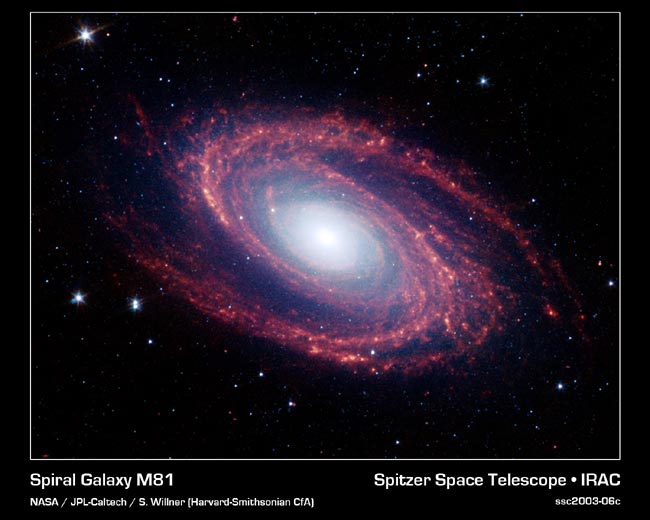Life's Building Blocks 'Abundant in Space'

The idea that comets and meteorites seeded an early Earth withthe tools to make life has gained momentum from recent observations of some ofthese building blocks floating throughout the cosmos.
Scientists scanning a galaxy 12 million light-years away withNASA's Spitzer Space Telescope detected copious amounts of nitrogen containingpolycyclic aromatic hydrocarbons (PANHs), moleculescritical to all known forms of life.
PANHs carry information for DNA and RNA and are an important component ofhemoglobin, the molecule that transports oxygen through the body. They alsomake chlorophyll, the main molecule responsible for photosynthesis in plants,and – perhaps most importantly – they're the main ingredient incaffeine and chocolate.
"There once was a time that the assumption was that theorigin of life, everything from building simple compounds up to complex life,had to happen here on Earth," said study leader Doug Hudgins of Ames Research Center. "We'vediscovered that some very biologically interesting molecules can be formedoutside our earthly environment and delivered here."
Wherever there's a planet ...
While organic compounds have been discovered in meteorites thathave landed on Earth, this is the first direct evidence for the presence ofcomplex, important biogenic compounds in space. So far evidence suggests that PANHs are formed in the winds of dying stars and spread allover interstellar space.
"This stuff contains the building blocks of life, and nowwe can say they're abundant in space," Hudgins said. "And whereverthere's a planet out there, we know that these things are going to be rainingdown on it. It did here and it does elsewhere."
Get the Space.com Newsletter
Breaking space news, the latest updates on rocket launches, skywatching events and more!
Using the Spitzer Space Telescope, Hudgins and his colleaguesdetected the familiar chemical signature of regular polycyclic aromatichydrocarbons (PAHs) in the spiral galaxy M81, as wellas a similar, but unknown signature.
"There were a few anomalies in the spectrum that wecouldn't explain," Hudgins told SPACE.com.The researchers compared their readings to the infrared signatures of similarmolecules, finally settling on nitrogen containing PANHsbecause their data showed there was nitrogen in the regions they wereinvestigating.
"When we did that, we found that by putting a littlenitrogen in these molecules explained the troubling molecules," Hudginssaid. "This discovery takes this reservoir of molecules that we didn'tthink were interesting and transforms all this stuff into something of biologicinterest."
The chicken wire of life
PAHs are flat, chicken-wire shapedmolecules made up of carbon and hydrogen, interesting to scientists becauselife on Earth is carbon-based. However, PAHs are notused in human biochemistry. In fact, they're better known as cancer-causingcarcinogens and environmental pollutants.
But swap a carbon atom with a nitrogen and a PAH becomes aPANH, a class of molecules critical to humans. Without nitrogen, it would beimpossible to build amino acids, proteins, DNA, RNA, hemoglobin, and many otherimportant molecules.
Here on Earth, Nitrogen makes up 78 percent of the atmosphereand is a key member of CHNOPS – carbon, hydrogen, nitrogen, oxygen,phosphorus, and sulfur – the group of ingredients most important formaking life and staples of organic chemistry.
It's also the main component of ammonia, which is used infertilizers and explosives on Earth, but has also been detected in Jupiter's atmosphereand possibly in Titan's icylakes.
PANHs aren't the first of life'sbuilding blocks to be discovered in space – amino acids, the nuts andbolts of proteins, have also been found inthe tails of comets. Meteoritesthat have landed in Australia and Antarctica also contain amino acids and PANHs.
"This tells us that these things that we see out in spacecan survive interstellar space and successfully be delivered to the surface ofa planet," Hudgins said.
Does not mean life
Some scientists even think that a Martianmeteorite found in Antarctica shows signs of extraterrestrial bacteria andthat sugar-loadedasteroids may have fed early life on our planet.
While PANHs are abundant ininterstellar space, Hudgins says this doesn't prove that terrestrial life hasextra-terrestrial origins. But, to paraphrase Occam'sRazor, given two equally likely theories, choose thesimpler.
"This isn't proof that they were used, but a likelysuggestion," Hudgins said. "They were present in abundance at thedawn of time and could have been useful in creating the first life form."
These findings are detailed in the Oct 10 issue of the Astrophysical Journal.
- Expedition Turns Up Life on Pseudo-Mars
- Scientists Confront 'Weird Life' on Other Worlds
- How Comets Might Seed Planets
- Fossilized Bacteria Found in Ancient Meteorite
Join our Space Forums to keep talking space on the latest missions, night sky and more! And if you have a news tip, correction or comment, let us know at: community@space.com.









